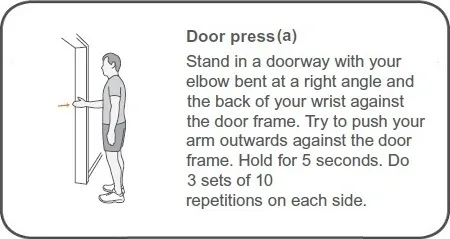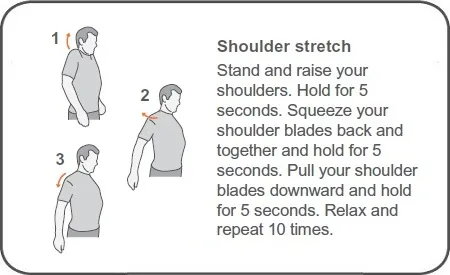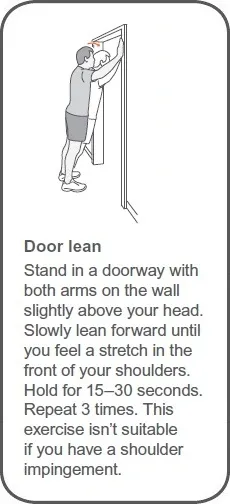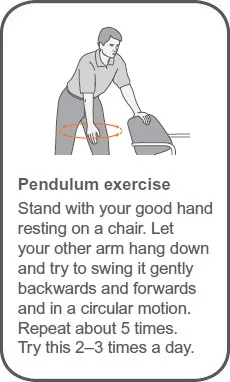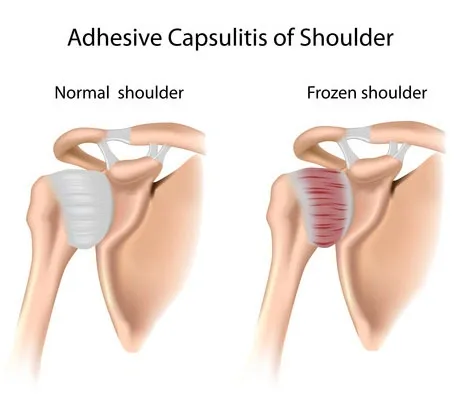David T. Turdy
How does the shoulder
work?
Your shoulder is the most mobile joint in your body. This is because your main shoulder joint (the glenohumeral joint) is a ball-and-socket joint. Ball-and-socket joints allow for the most amount of movement of all the different types of joints in your body.
Ball-and-socket joints get this name because the ball-shaped upper arm bone (the humerus) fits into the cup-like hollow of the top part of your shoulder blade bone (the scapula).
Your shoulder joint is surrounded by a tough fibrous sleeve, called the capsule, which helps to hold the joint together. The inner layer of the capsule (the synovium) produces a fluid which nourishes the cartilage and lubricates the joint so it moves more smoothly. A group of four muscles and their tendons make up the rotator cuff, which controls movement and also helps to hold the joint together.
There’s also a smaller joint (the acromioclavicular joint) where the top of your shoulder blade meets your collarbone, above the main shoulder joint.

What causes shoulder pain?
Most shoulder problems will only affect a small area and are fairly short-lived. There are several possible causes, including:
- inflammation or damage to the muscles and tendons around the shoulder
- tension in the muscles between the neck and shoulder (common in people with poor upper back or neck posture, often linked to their work)
- inflammation in the sac of soft tissue (bursa) that normally allows the muscles and tendons to slide smoothly over the shoulder bones
- damage to the bones and cartilage, which can be caused by arthritis.
Referred pain
Shoulder pain isn’t always caused by a problem in your shoulder joint. For example, problems in your neck can cause pain over your shoulder blade or in your upper outer arm. This is known as referred pain.
If you have shoulder pain and a tingling sensation in your arm or hand, this is also more likely to be caused by a problem in your neck.
Arthritis
Sometimes shoulder pain may be part of a general condition such as:
- rheumatoid arthritis
- osteoarthritis
Rheumatoid arthritis quite often affects the shoulders. Osteoarthritis is less likely to affect the shoulders than other joints, but it can sometimes follow on from previous shoulder injuries.
Should I see a doctor
about my shoulder pain?
Unless you have a traumatic injury or experience sudden and continuing pain, there’s no need to see your doctor straight away. But if the pain doesn’t improve after about two weeks then you should see your doctor or an experienced acupuncturist or a physiotherapist in case you have a more complex problem.
You should see your doctor as soon as possible if you:
- develop severe pain in both shoulders
- also have pain in your hips or thighs
- also feel feverish or unwell.
There are several ways you can help yourself if you have shoulder pain.
Apply heat or cold to the joint
If your shoulder pain is due to a recent injury or is inflamed (warmer to touch than the other side), an ice pack may be helpful. Leave the ice pack in place for 10 minutes or so.
For most other types of shoulder pain, heat packs can help to ease the pain, particularly if your muscles feel sore and tense. You can use:
- a reusable heat pad (which you can buy from chemists and sports shops)
- a microwaveable wheat bag
- a hot-water bottle.
Don’t put heat or ice packs directly onto your shoulder, to avoid burning or irritating your skin. Wrap them in a towel (a damp towel for ice packs) before you put them on your skin.
Improve your posture
Poor posture or working habits can make shoulder problems worse. This can include shoulders becoming rounded and slouching, particularly when you’re sitting at a desk.
Leaning forwards for long periods when sitting, with pressure through your arm or with your arm held tightly by your side, can make the problem worse, especially if some of the pain is coming from your neck.
Changing your position frequently and sitting in a supported upright position may be helpful.
Your upper body posture improves if your lower back is supported. When sitting, you may need to place a pillow or cushion behind your lower back, depending on the chair. Make sure your arm is supported and that you feel comfortable. If your shoulder is really sore, consider supporting your arm using a cushion or pillow on your lap.
Look into a mirror and make a conscious effort to hold your shoulder blades up and back. This should make your chest stand out as if you were taking a deep breath.
If your shoulder is painful to lie on, sleeping in the following positions may reduce the discomfort:
- Lie on your good side with a pillow under your neck.
- Use a folded pillow to support your painful arm in front of your body.
- Another pillow behind your back can stop you rolling back onto your painful side.
- If you prefer to sleep on your back, use one or two pillows under your painful arm to support it off the bed.
Reduce the strain on your shoulders
Generally it’s best to carry out your normal activities, but don’t over do it. Your body is designed to move but you may need to pace yourself and try to gradually do a bit more each day.
At home:
- When vacuuming, keep your upper body upright with the cleaner close to your body, and use short sweeping movements.
- Only iron essential items, and make sure the ironing board is at waist height.
- Use a trolley or a backpack to carry shopping, or divide the weight between two bags and carry one in each hand. Alternatively, use bags with long straps and carry them with the straps crossed over your body from your shoulder to your hip.
- Limit the amount of time when you’re sat looking at tablets and mobile phones. Instead use a stand and place them on a table to reduce neck strain.
- When doing DIY (such as painting and cleaning the walls or ceiling) try to give yourself enough time to finish the task and ask for help if you need it. Take lots of rests by moving around, and switching tasks and positions if you can.
At work:
- Try to maintain a good posture when sitting or standing. Avoid holding your neck in fixed or twisted postures.
- If you work at a desk or workstation, try to get up and move around every so often. Make regular gentle movements through the full range of your neck and shoulders.
- If you use a computer, keep the keyboard and monitor directly in front of you so you don’t have to turn your head or twist your body. Keep the mouse within easy reach so you don’t have to stretch.
- Don’t trap the phone between your head and your shoulder when you’re making a call. If you’re on the phone a lot, use a headset.
- Avoid any manual work that hurts while you’re doing it.
If your job involves repetitive actions and/or awkward postures that might contribute to your shoulder problems, it’s important to look for advice.
Get a balance between rest and exercise
Aim for a balance between rest and activity to prevent your shoulder from stiffening. Try to avoid the movements that are most painful, especially those that hold your arm away from your body and above shoulder height. It’s important to remain generally active, even if you have to limit how much you do.
When raising your arm, you can reduce the strain or pull on your shoulder by:
- keeping your elbow bent and at the side of your body
- keeping your palm facing the ceiling when reaching up.
When lowering your arm, bend your elbow, bringing your hand closer to your body.
Our Treatment:
Most shoulder problems will benefit from acupuncture and tui na treatment. we will assess your condition and put together a tailored treatment programme.
The aim of our treatment is to improve symptoms and restore function. The approach will depend on whether you have a short-term (acute) problem or a long-standing (chronic) condition. Almost everyone will benefit from our programme, which might include:
- heat therapy
- needling with electro-stimulation
- Cupping and Moxa
- Tui Na massage to ease stiffness and break up the adhesive soft tissues
- advice on improving shoulder, neck and spine posture exercises to increase the range of joint movement
- applying herbal tape to improve pain
Exercises to manage shoulder pain
